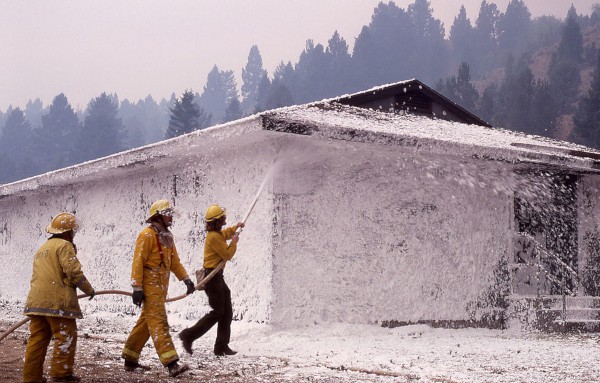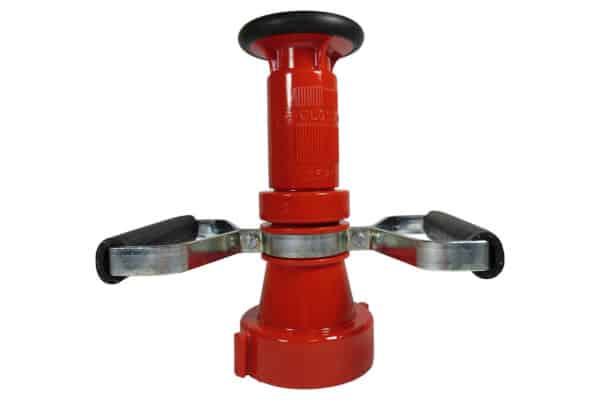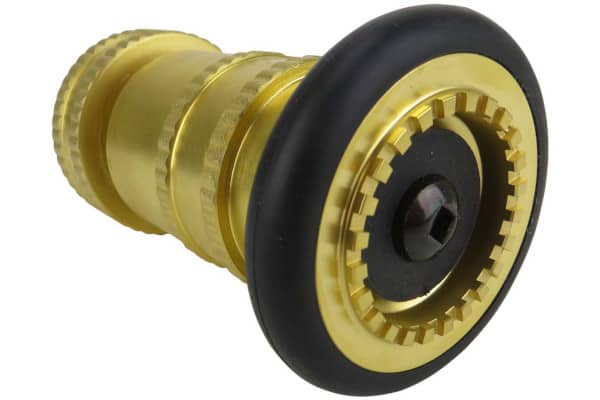The types and distinguishing characteristics of fire hose spray nozzles
Our previous blog looked at what you need to know when purchasing or maintaining a fire hose. But it’s the nozzles at the end of each fire hose that make it possible for firefighters to safely and thoroughly extinguish a blaze. Nozzles, like hoses, need to be easy to use, durable, and right for the task at hand. In this installment, we’ll look at the basic types of nozzles, what you need to know about their reliability and usefulness, and how you can keep them functioning well.
Already know what you’re looking for? Click here to shop our selection of nozzles.
Why do we have different kinds of fire hose nozzles?
To understand what makes a nozzle better-suited to some circumstances and not others, it’s important to understand a little about fire.
A fire needs three elements to ignite: fuel, heat, and oxygen. The fuel can be anything flammable, like firewood or gasoline. Heat adds energy to the fuel, causing the atoms inside it to vibrate. As these vibrations intensify, stable bonds between atoms begin to fall apart, vaporizing the fuel. The chemical reaction between these vapors and nearby oxygen creates fire.
Water is widely used in firefighting for the same reason it takes so long to boil: water resists changes in temperature. Water molecules can’t vibrate quickly unless the hydrogen bonds—the H2 in H2O—break, and that takes a lot of energy. As a result, dousing a fire with water can take away much of the fuel’s heat, interrupting the chemical reaction that sustains it.
But there’s more to fighting fires than spraying as much water as quickly as possible. Each situation requires firefighters to consider questions like:
- Will water travel far enough?
- Will the stream penetrate burning materials?
- Can heat and smoke be removed from the area using air currents created by moving water?
- How much water pressure is available?
- Does the area need to be cooled before firefighters can safely enter?
- Is the building still occupied and, if so, would steam created by firefighters harm those people?
In some instances, water may not be used at all. When the source of the flames is a flammable liquid, like gasoline or paint, it may be advantageous to use a foam-based extinguishing agent, which stops the fire’s chemical reaction by depriving it of oxygen. All of these considerations and more may weigh in favor of a particular nozzle for a particular use.
Pattern, pressure, and gallonage distinguish one fire hose spray nozzle from another
There are three major ways in which a nozzle’s output can vary:
- Pattern: the water’s shape as it exits the nozzle
- Pressure: the water’s force, measured in pounds per square inch (PSI)
- Gallonage or discharge rate: how quickly water flows from the nozzle, measured in gallons per minute (GPM)
Water pressure controls how far and how fast water moves as well as how deeply water penetrates burning materials. For firefighting, more gallons of water available means more extinguishing agent to cool the fire’s fuel. Each nozzle has an expected, or rated, gallonage at a rated pressure. For example, a nozzle may deliver 60 GPM at 100 PSI, and 50 GPM at 110 PSI.
The stream pattern produced by a nozzle makes an important difference in that nozzle’s firefighting properties. Fog nozzles produce a cone-shaped stream of small water droplets. These droplets can more easily be converted into steam, which takes heat from the surrounding air and can even be used to push hot air out of a room. Straight streams discharge water in the shape of a column. This gives the discharge greater reach and deeper penetration, but it’s not as effective for ventilating a space or absorbing ambient heat.

Standards from the National Fire Protection Association determine stream characteristics of many fire hose spray nozzles
The National Fire Protection Association, a leading authority on fire prevention in the United States, has created guidelines for spray nozzles. These standards, written in NFPA 1964: Standard for Spray Nozzles, determine how nozzles are constructed, including how narrow or how straight streams must be.
From the 2018 edition of NFPA 1964
4.2.1 Spray nozzles shall be capable of developing discharge patterns varying from straight stream to at least 100 degrees spray angle.
4.2.2 The straight stream pattern setting shall provide a cohesive jet capable of delivering 90 percent of the rated discharge within a circle 12 in. (305 mm) in diameter at a distance of 10 ft (3 m) from the nozzle if the nozzle’s rated discharge is less than 350 gpm (1325 L/min), and within a circle 15 in. (381 mm) in diameter at a distance of 10 ft (3 m) from the nozzle if the nozzle’s rated discharge is 350 gpm (1325 L/min) or greater.
Pressure and gallonage settings aid in the categorization of fire hose spray nozzles
NFPA 1964 divides nozzles into four major types according to whether that nozzle has variable settings for pattern, pressure, or gallonage.
From the 2018 edition of NFPA 1964
3.3.18.1* Basic Spray Nozzle. An adjustable-pattern spray nozzle in which the rated discharge is delivered at a designated nozzle pressure and nozzle setting.
3.3.18.2* Constant Gallonage Spray Nozzle. An adjustable-pattern spray nozzle that discharges at a constant discharge rate throughout the range of patterns from a straight stream to a wide spray at a designated nozzle pressure.
3.3.18.3* Constant Pressure (Automatic) Spray Nozzle. An adjustable-pattern spray nozzle in which the pressure remains relatively constant through a range of discharge rates.
3.3.18.4* Constant/Select Gallonage Spray Nozzle. A constant discharge rate spray nozzle with a feature that allows manual adjustment of the orifice to effect a predetermined discharge rate while the nozzle is flowing.
The NFPA uses these categories to decide what’s acceptable for each nozzle in terms of pressure and gallonage. Each sort of nozzle produces a different kind of stream, and these streams have important lifesaving and firefighting properties.
With a basic spray nozzle, both GPM and PSI vary as the stream shifts from a straight pattern to a fog pattern. Constant pressure nozzles, on the other hand, help to guarantee the reach of a stream with a self-adjusting component designed to keep water pressure steady.
Constant gallonage nozzles maintain the same orifice size as the nozzle pattern changes. Whether they’re spraying in a straight-stream or a fog stream pattern, these nozzles maintain a fairly constant GPM. While constant gallonage nozzles have a fixed orifice—and therefore one fixed discharge rate—constant/select gallonage spray nozzles allow firefighters to choose from one of several orifice sizes that guarantee consistent flow rates across all patterns.
Adjustable-pattern fire hose spray nozzles provide versatility, while simpler nozzles can resist clogging
Automatic, or adjustable, nozzles can adjust to increases or decreases in flow. Streams can maintain the proper shape, achieve maximum reach with the water available, and keep the correct nozzle pressure for the available gallonage.
Nozzles with a fixed-size or manually-adjusted opening may be particularly sensitive to changes in flow. Supplying too little water creates a weak stream, while supplying too much can make the stream erratic and the nozzle harder to control.
This doesn’t mean that nozzles with adjustable openings are always the best choice. The water supplied by standpipes—piping systems used to deliver water throughout multi-story buildings—may contain rust, trash, or other objects. Automatic nozzles rely on valves and springs to regulate the size and shape of the water. As a result, debris can occasionally obstruct automatic nozzles, as it does in the video below.
Curious about standpipe systems but don’t know where to start? Take a look at our blog series on standpipe systems.
On the other hand, a manual nozzle with fewer features may pass debris more easily. Smooth bore nozzles, for example, are simple, cylindrical nozzles designed to discharge in a straight stream. Smooth bore nozzles are different than adjustable or automatic nozzles in that they don’t have any internal parts to control gallonage or pressure. While every nozzle has some debris-flushing capacity, the smooth bore’s internal simplicity allows debris to pass more easily.
Many nozzles can fight fires with foam-based solutions

Standard nozzles, including the smooth-bore nozzle, can discharge foam solutions in many cases. Depending on the kind of foam used, the foam system, and the situation, some nozzles may work far better than others.
While a detailed look at these uses is beyond the scope of this article, fire protection engineer Greg Jakubowski at FireRescue Magazine has examined this subject in detail. His article, which includes the NFPA’s recommendations on nozzle choice, is available here.
Each jurisdiction chooses its own fire hose couplings, making a careful selection of fire hose nozzle threads critical
Each nozzle connects to a hose by threads or couplings—but not every hose has the same threads. The nozzle needs a thread connection of a compatible size and type.
Threading standards vary from place to place. While two standard types of threads are predominant—National Standard Thread (NST) and National Pipe Straight Hose Thread (NPSH)—many major cities have their own threading standards.
Want to learn more about fire hose threading standards? Take a look at our blog on common types of threads used in fire protection.
If you’re looking to purchase a nozzle for a hose you already have, you may be able to easily determine which threads you have by following these steps:
- Look at the couplings on both ends. Is there a male coupling, with threads outside, and a female coupling, with threads inside?
- If so, look for lettering on the female coupling. The letters NH or NST indicate that the coupling uses National Standard Thread, while the letters NPSH indicate that the coupling has National Pipe Straight Hose Thread.
- Measure the outside diameter of the male thread, including the width of the threads themselves.
If you’re having difficulty determining the thread size, your local fire authorities can tell you which threads are used in your area.
Fire hose nozzle reaction and activation can significantly limit usability
As the amount and pressure of water discharge increases, nozzles become more difficult and more tiresome to control. At 50 PSI, a smooth-bore nozzle with a 15/16-inch diameter pushes against the nozzle operator with 68 pounds of force.
That force, called nozzle reaction, can make extinguishing a fire tricky. Because a basic spray nozzle operates at a designated pressure and gallonage, nozzle reaction can only be reduced by changing the supply. But because an under or over-pressurized water supply may diminish the stream’s efficacy, only limited changes can be made.
This makes nozzle selection critical. At least one study has suggested that nozzle reaction should be limited to 60 pounds of force for a single firefighter and 75 pounds of force for a team of two. For this reason, many fire departments use nozzles rated at pressures of 50 or 75 PSI. These pressures reduce nozzle reaction while still ensuring that an adequate supply of water is available to extinguish the flames.
Higher pressures can make a nozzle difficult to control. As such, it’s critical that each nozzle be easy to activate, deactivate, and adjust. NFPA 1964 sets a minimum and maximum amount of force required to operate a nozzle’s lever or rotational control. Each should open with no less than three pounds of force. NFPA 1964 also specifies that lever-type controls may take as much as 16 pounds of force to depress, and rotational-type controls up to 40 pounds of force to rotate.
NFPA standards establish criteria for the durability of fire hose spray nozzles at various pressures and temperatures
NFPA 1964 also establishes the durability range for the nozzle’s components, including the ability to withstand high water pressures and high and low temperatures.
To ensure that nozzles won’t break under pressure, hydrostatic pressure tests are conducted. During these tests, nozzles are subjected to pressures far greater than they’re expected to operate at.
From the 2018 edition of NFPA 1964
6.6.1.1 The nozzle or appliance shall be mounted in a closed position on a device capable of exerting a hydrostatic pressure of 900 psi (62 bar) or three time the maximum rated pressure, whichever is higher.
This pressure is gradually increased in 30-second increments until the maximum pressure is reached. If the nozzle leaks anywhere other than the orifice, the pressure test is failed.
During high and low-temperature tests, nozzles are kept at a high temperature of 135 degrees Fahrenheit or a low temperature of -25 degrees Fahrenheit for 24 hours. This test requires that the nozzle’s adjustments and controls still work immediately after the test concludes.
Fire hose spray nozzles are specifically tested for impact-resistance
Rough-handling tests consist of dropping the nozzle on a charged or uncharged hose from a specified height to ensure that the nozzle can withstand impacts to the handle or lever, body, handholds, opening, and couplings.
From the 2018 edition of NFPA 1964
4.9.2 The nozzle shall not deform or break beyond the point where it affects the operational use of the nozzle as defined in the requirements of this standards.
4.9.3 All nozzle functions such as pattern selection, flush, flow rate adjustment, and shutoff shall operate as described in Section 4.3. The operating force shall not increase more than 10 percent from that allowed before the test.
4.9.4 Following performance of the test in 4.9.3, samples shall again be subject to the leakage test defined in Section 4.7. The leakage shall not increase by more than 10 percent from that allowed before the test.
These requirements ensure that the nozzle can withstand a variety of impacts and still remain largely intact.
NFPA standards also govern the inspection and maintenance of fire hose spray nozzles
The standards we’ve looked at so far are cited from the NFPA’s volume on spray nozzles. Maintenance, on the other hand, is covered by NFPA 1962: Standard for the Care, Use, Inspection, Service Testing, and Replacement of Fire Hose, Couplings, Nozzles, and Fire Hose Appliances.
After each use, and at least annually, every nozzle must be inspected.
From the 2018 edition of NFPA 1962
5.2.2 The nozzle inspection shall verify the following:
(1) The waterway is clear of obstructions.
(2) There is no damage to the tip.
(3) All controls and adjustments operate as designed.
(4)* The shutoff valve, if so equipped, operates as designed and closes off the flow completely.
(5) There are no missing or broken parts.
(6) The thread gasket is in good condition in accordance with Section 7.2.5.2.3 If the nozzle fails the inspection for any reason, it shall be removed from service, repaired and service tested, or replaced.
Each time the nozzle is used, it must also be washed, tested, and lubricated.
From the 2018 edition of NFPA 1962
A.5.1.6 Nozzles should be washed in a solution of soap and warm water. The nozzle should be submerged and the adjustable controls operated until there is free movement. The nozzle should then be rinsed in water. The nozzle should be lubricated in accordance with the manufacturer’s instructions. Cracked rubber-covered handles can cause accidents and should be replaced.
Straight stream and automatic fire hose spray nozzles are available at QRFS

At QRFS, we’re happy to help you choose a nozzle that’s right for the job. We carry nozzles and adapters in sizes from 3/4-inch to 2 1/2 inches at 75 GPM, 150 GPM, and more. These nozzles meet or exceed NFPA standards. Each is constructed from impact and corrosion-resistant Lexan or brass, and available with handles, a pistol grip, or an impact-reducing bumper. National Standard Thread or National Pipe Straight Hose threads are in stock. Other threads and adapters are available upon request.
Click here to shop our selection of brass, Lexan, and pistol-grip fire hose spray nozzles.
Questions about fire hose nozzles? Call us at +1 (888) 361-6662 or email support@qrfs.com.
This blog was originally posted at blog.qrfs.com. If this article helped you find a solution, check us out at Facebook.com/QuickResponseFireSupply or on Twitter @QuickResponseFS.
Lexan is a registered trademark of SABIC Global Technologies.


